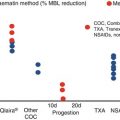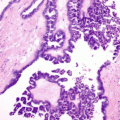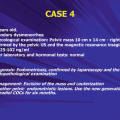© International Society of Gynecological Endocrinology 2015
Bart C. J. M. Fauser and Andrea R. Genazzani (eds.)Frontiers in Gynecological EndocrinologyISGE Series10.1007/978-3-319-09662-9_1111. Effects on Sexual Function of Medical and Surgical Therapy for Endometriosis
(1)
Division of Obstetrics and Gynecology, University Hospital of Geneva, Boulevard de la Cluse 30, Geneva, 1205, Switzerland
11.1 Background
Endometriosis is a chronic and progressive disease affecting 1 out of 10 women during reproductive years. Unfortunately the majority of these women has not been diagnosed and treated early. The most common complaints of women with endometriosis are pelvic pain and infertility. Pain may take the form of dysmenorrhea, deep dyspareunia (DD), chronic pelvic pain, menstrual dyschezia, or cycle-dependent dysuria. More than half of women with endometriosis experience dyspareunia during their entire life. However, DD is a heterogeneous disorder, and other conditions may overlap to endometriosis contributing to the pathogenesis of the pain during intercourse. Pelvic adhesions, pelvic congestion, pelvic inflammatory disease, and interstitial cystitis may cause DD. The relation between pain and endometriosis is not yet clearly understood.
11.2 Sexual Function
Sexual function is an important aspect of health and quality of life, likely to be influenced by medical conditions and health-care interventions, especially when gynecologic disorders are involved. Pain at intercourse is among the factors that affect sexual functioning. However, sexuality is a complex phenomenon influenced by psychosocial (personality, former experience, personal attitudes toward sexuality) as well as physiological factors affecting not only physical health but also psychological well-being and therefore conducting to reduced sexual function. In addition, personality traits, coping capacity, degree of couple intimacy, partner emotional support, participation, solicitousness or hostility, marital adjustment, and even quality of medical information and care may greatly influence the level of perception, interpretation, and acceptance of such a multifaceted symptom [1–3]. Sexual dysfunction can be evaluated using multidimensional questionnaires including, among others, the Female Sexual Function Index (FSFI), the McCoy Female Sexuality Questionnaire, and the Sabbatsberg Sexual Self-Rating Scale.
11.3 Sexual Function and Endometriosis
Endometriosis constitutes the most frequent organic origin of DD, and women with the disease have a ninefold increase in risk of experiencing this symptom compared with the general female population of corresponding age [4]. DD is particularly upsetting because it usually occurs when intercourse is attempted, whereas dysmenorrhea and dyschezia typically afflict women for a limited number of days each month. The experience of pain and the loss of pleasure are recurrently recognized and become reinforced by repeated experiences. Pain during coital activity may be caused by traction of scarred and inelastic parametria, by pressure on endometriotic nodules, by infiltration of subperitoneal or visceral nerves, and by immobilization of posterouterine pelvic structures. In addition to these reasons for painful intercourse, women with endometriosis generally experience major exacerbation of pain when minor pressure is exerted on nodules or indurated lesions. Moreover there is evidence that the presence of endometriosis is associated with increased pain perception. This type of neuropathic pain is usually related to nerve injury or inflammatory stimuli, conditions found in deep infiltrating endometriosis (DIE) [5]. DIE is defined a form of endometriosis that penetrates for more than 5 mm under the peritoneal surface [6]. It is estimated that its incidence is around 20 % of women with endometriosis. DD is present in two-thirds of patients with DIE compared with one-half of those with peritoneal or ovarian lesions [4]. Anatomic locations of DIE seem to be associated with the prevalence of DD [7]. In particular, DD was found to be 90 % in case of uterosacral ligaments’ infiltration, 42 % in case of bladder involvement, 40 % in case of adnexal adhesions, 27 % in case of bowel involvement, and 25 % in the presence of endometrioma. Among subjects with DD, those with DIE of the uterosacral ligaments or the vagina have the most severe impairment of sexual function, as assessed by both quantity and quality of sexual experience [8, 9]. This correlation can be explained by the fact that the uterosacral ligaments contain a considerable amount of nerve tissue and that neural invasion by endometriotic lesions is correlated with the severity of pain. In addition, the presence of a vaginal nodule may affect sexual function through its direct stimulation during intercourse.
Sexual problems are distressing for women as feelings of guilt, sacrifice, and resignation encourage these women having sexual intercourse even if they suffer from dyspareunia. These facts show that partner’s pleasure is more important for many women than their own pleasure. On the other hand, women with dyspareunia have lower frequency of intercourse and lower levels of desire and experience fewer orgasms. However, only limited information is available about the consequences of symptomatic endometriosis on female sexual function, especially in case of DIE. In this group of patients, sexual dysfunction seems to arise and increase during time, most probably as a result of the development of deep lesions. Fritzer et al. [10] evaluated 125 patients with dyspareunia lasting for at least 6 months. They reported a prevalence of 78 % of sexual dysfunction in women with endometriosis and almost half of them had sexual dysfunction and sexual distress simultaneously. The results of coital pain were a reduced number of episodes of sexual intercourse, interruption, and avoidance. Not surprisingly, more than half of women were afraid of pain before/during sexual intercourse. These results were confirmed by another cross-sectional study made by Jia et al. [11] which also reported a prevalence of 73 % of sexual dysfunction among 111 women with endometriosis. Authors found that pain intensity (OR 0.3) and III-IV AFS (OR 4.4) are negatively associated with sexual function. Advanced stages are often associated with development of considerable adhesions in the pelvic cavity, resulting in the immobilization of pelvic organs during coital activity. However, a case control study by Varcellini et al. [4] found little differences regarding sexual dysfunction, between the different locations of DIE. Endometriosis seems to impair all aspects of sexual life including orgasm, satisfaction, and desire, but the relationship between endometriosis and sexual dysfunction is much more complex than can be explained by anatomic distribution of lesions. No significant correlation could be demonstrated between severity of dyspareunia and sexual functioning, suggesting that that DD should be viewed in a broader clinical perspective, considering also the potential psychological and interpersonal consequences.
11.4 Endometriosis Comorbidities and Sexual Function
Depression is related with chronic pelvic pain, and there is no consensus as to which the cause is and which is the consequence. Women suffering from endometriosis present greater susceptibility to mental disorders. On the other hand, depression and anxiety also play a role in the development and chronicity of pelvic endometriosis. Although depression in women with chronic pelvic pain has been the target of many studies, it continues to be underdiagnosed. Certain factors can contribute to the development of mental disorders in women with chronic pelvic pain. Factors related to emotional suffering (socioeconomic condition, history of physical or sexual abuse, and domestic violence) and low socioeconomic level are some of them. The infertility caused by pelvic endometriosis can also contribute to the development of mental disorders. A recent study by Sepulcri and do Amaral [12] evaluated 104 patients with endometriosis and found a prevalence of 86.5 % for depressive symptoms (mild in 22.1 %, moderate in 31.7 %, and severe in 32.7 %) and 87.5 % for anxiety (minor in 24 % and major in 63.5 %). The high prevalence may be explained by the fact that women with pain and anxiety show less tolerance to pain. The intensity of pain was significantly correlated with depression and anxiety.
Stay updated, free articles. Join our Telegram channel

Full access? Get Clinical Tree







